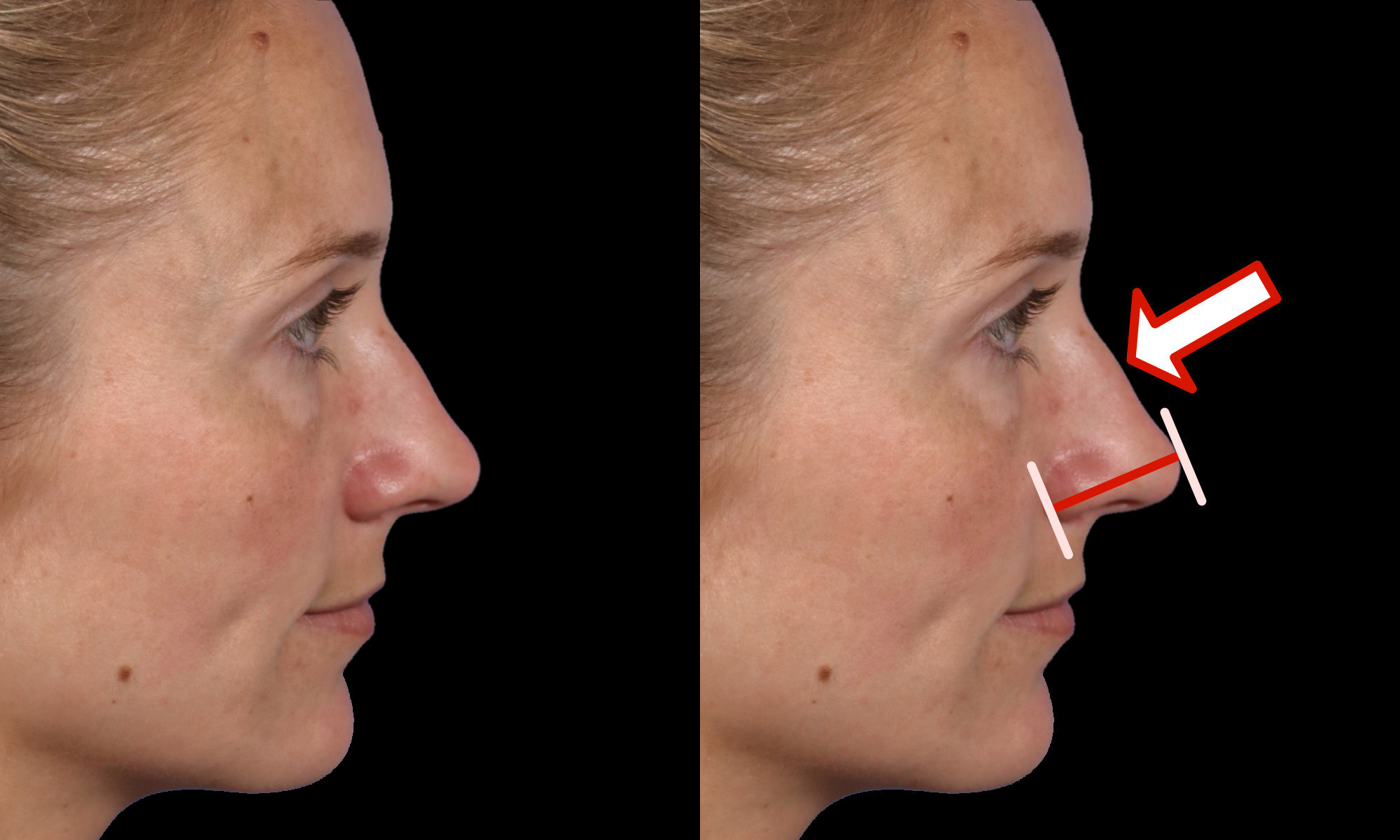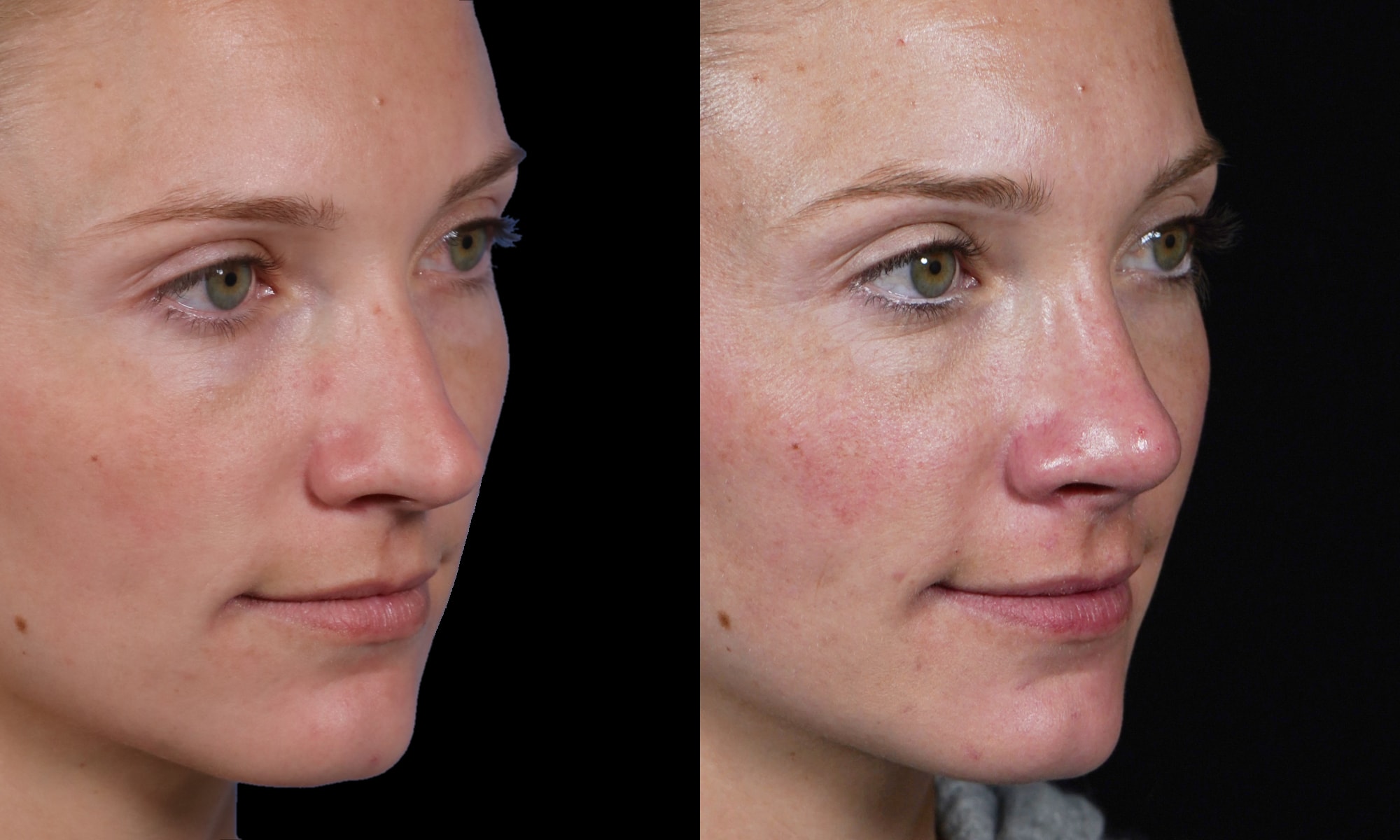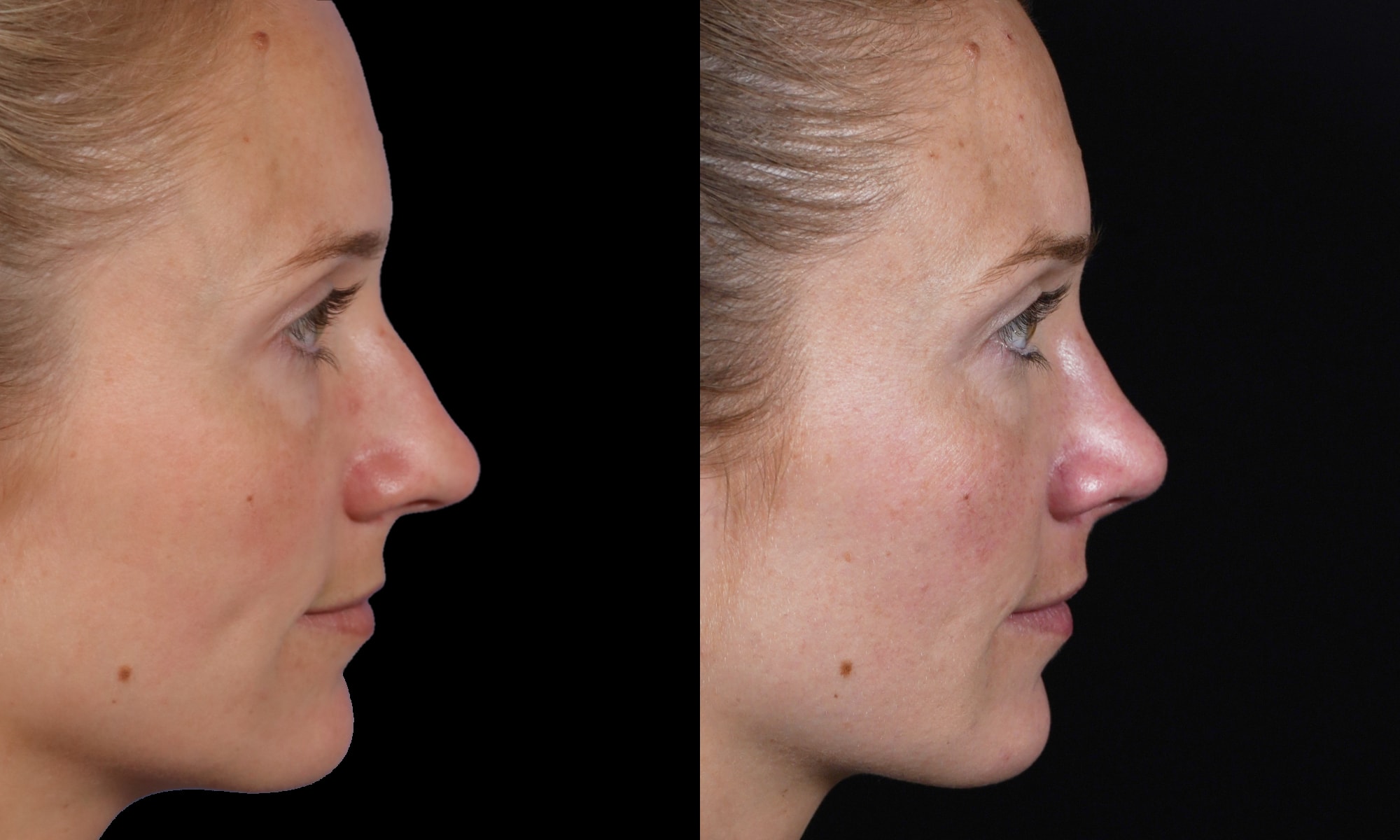People have been inquiring about preservation rhinoplasty results so we wanted to put up a quick post.
 This is a young lady who desired lowering of her nasal bridge as well as deprojection of her nasal tip (bringing the tip closer to the face). When you looked at her nose, you could see that it was just a bit oversized for her face. The hump on the nasal bridge certainly contributed to this issue of her nose looking too big. In combination with this, her nasal tip also stuck out too far. This is indicated in the adjacent photo diagram by the red line, which corresponds to what we call the nasal tip projection. Some patients often times erroneously refer to this as nasal length – commonly saying that their nose is too long. But in plastic surgery jargon, this is more accurately referred to as projection. Length of the nose is actually reserved for describing something entirely different.
This is a young lady who desired lowering of her nasal bridge as well as deprojection of her nasal tip (bringing the tip closer to the face). When you looked at her nose, you could see that it was just a bit oversized for her face. The hump on the nasal bridge certainly contributed to this issue of her nose looking too big. In combination with this, her nasal tip also stuck out too far. This is indicated in the adjacent photo diagram by the red line, which corresponds to what we call the nasal tip projection. Some patients often times erroneously refer to this as nasal length – commonly saying that their nose is too long. But in plastic surgery jargon, this is more accurately referred to as projection. Length of the nose is actually reserved for describing something entirely different.
For the two main cosmetic issues – the dorsal hump and overly projected nasal tip – Dr. Hilinski recommended cosmetic septorhinoplasty surgery to help make her nose look smaller overall. Although taking the nasal hump down is something that rhinoplasty experts do all the time, bringing the tip closer to the face, or deprojection of the nasal tip, is not nearly as common.
Preservation Rhinoplasty
In planning out her cosmetic rhinoplasty procedure, Dr. Hilinski ultimately decided to use a preservation rhinoplasty technique. This highly specialized type of rhinoplasty surgery is rooted in the fact that much, if not all, of the nasal structures are more or less preserved rather than being resected, or cut out. For example, when it comes to her nasal hump, classic rhinoplasty surgery would dictate that the surgeon simply rasp or sand down the bump to the desired height. But bumps are made of both bone and cartilage. The bony portion of the hump is amenable to sanding it down. But the cartilage portion of the nasal hump requires resection or cutting. Whenever this is done in combination, you can imagine that the native anatomy and support structure of the nasal bridge is significantly compromised. After all, a good portion of the cartilage and bone are being sanded and cut away. To some extent, this disrupts the natural, smooth bridge contour and can, in some cases, lead to irregularities in the appearance of the nose.
 This can take the form of unwanted bumps and shadows. In an attempt to minimize development of these postoperative cosmetic nose deformities, preservation rhinoplasty techniques are now being used more frequently. So what do we mean by preservation rhinoplasty when it comes to taking a hump down from the bridge? Instead of ‘sanding down’ the bridge and/or cutting the cartilage down, the bridge height is reduced from underneath. This is graphically demonstrated in the adjacent photo where you can see that the top of the bridge is moved back closer to the face to achieve a new, lower height.
This can take the form of unwanted bumps and shadows. In an attempt to minimize development of these postoperative cosmetic nose deformities, preservation rhinoplasty techniques are now being used more frequently. So what do we mean by preservation rhinoplasty when it comes to taking a hump down from the bridge? Instead of ‘sanding down’ the bridge and/or cutting the cartilage down, the bridge height is reduced from underneath. This is graphically demonstrated in the adjacent photo where you can see that the top of the bridge is moved back closer to the face to achieve a new, lower height.
 Another way to explain how and why this is being done to the nose is to think of the bridge as the tip of an iceberg. In the accompanying graphic, you can see the starting point of the iceberg (or bridge of the nose). Remember our goal here is to reduce the height of the iceberg while maintaining its natural shape as much as possible.
Another way to explain how and why this is being done to the nose is to think of the bridge as the tip of an iceberg. In the accompanying graphic, you can see the starting point of the iceberg (or bridge of the nose). Remember our goal here is to reduce the height of the iceberg while maintaining its natural shape as much as possible.
One option (see ‘B’) is to sand down, or cut down, the iceberg to achieve the new, desired height. In doing so, the entire tip of the iceberg has to be reshaped. Although the new shape can closely mimic the old shape, it is still different to some degree. Take a close look at the tip of the iceberg in ‘A’ versus ‘B’ and you can see they are, indeed, different in terms of the shadows and highlights. This is not surprising given the fact that the iceberg was reshaped in a 360 degree manner. When it comes to the nasal bridge, the same concept applies – the new bridge can be made to look very similar to the old bridge, but it is technically still different. And when it comes to the nasal bridge, subsequent scarring and healing can lead to changes that may result in unwanted cosmetic irregularities.
An alternative method of achieving a lower height is to take away an inside layer of the iceberg (see ‘C’) and allow the remaining portion to drop down. This results in a lowering of the overall height by an amount equal to the amount of removal done below the surface level. As is shown here (see ‘D’), the tip of the iceberg drops down to achieve a new position and location – but is the same shape and contour with the same shadows and highlights as it was before. In fact, it IS the same as it was before. And since the intrinsic surface topography was not altered to any significant degree, it looks nearly identical. That is essentially what we are doing with preservation rhinoplasty when it comes to the nasal bridge. We are taking away a layer of cartilage and bone inside of the nose and below the bridge, thus allowing movement of the native bridge shape and contour to the desired, new, lower position. And since we haven’t altered the surface anatomy to any great extent, subsequent scar tissue during the healing process is unlikely to lead to unwanted cosmetic irregularities – leaving the bridge of the nose nice and smooth.
Preservation Rhinoplasty Case
Given the advantages with using preservation rhinoplasty technique, Dr. Hilinski elected to choose this method for this particular case. But in addition to needing the bridge height reduced, this patient needed to have the nasal tip brought closer to the face – called ‘deprojection’ of the nasal tip.
As you can see, her nasal bridge has been nicely reshaped – including a reduction in the height – and the tip is now less projected. And if you look very closely, you can see that the nasal bridge contour is very smooth and natural looking. The same could be said for her nasal tip as well. It has been deprojected and made to look just a bit more defined and refined.
Overall, though, she still looks quite natural, which is always the goal when it comes to cosmetic rhinoplasty.



